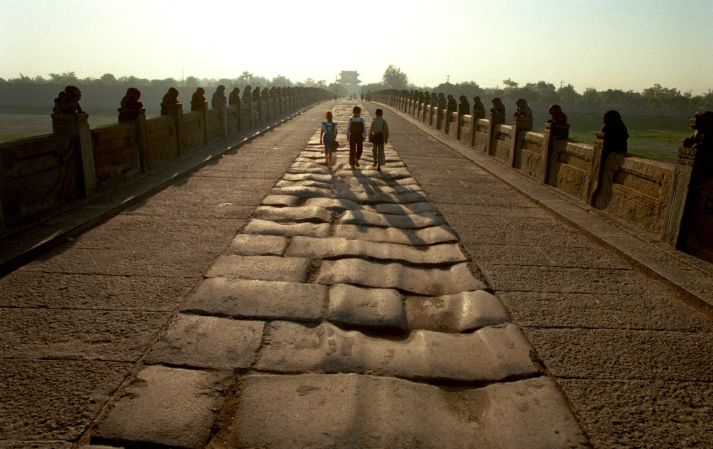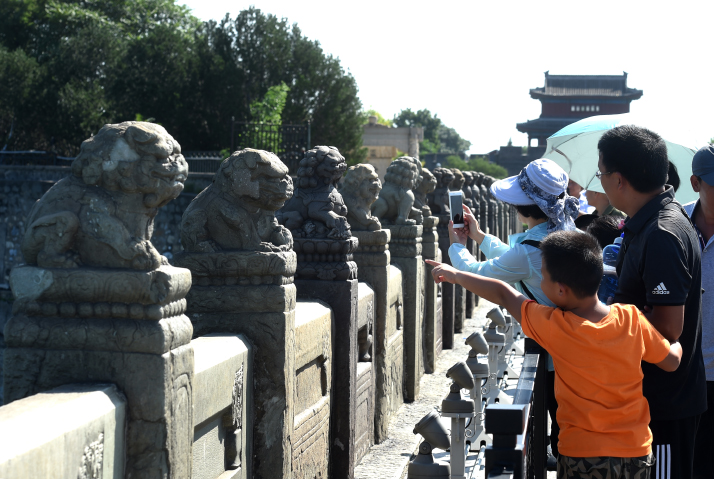| Lifestyle |
| Lugou Bridge and the Beijing flood | |
|
|
 Grooves in the stone-paved surface of Lugou Bridge have been worn by centuries of traffic (XINHUA)
On July 29, as Beijing residents battened down the hatches for what would be the city's heaviest rainfall in 140 years, authorities began preparing to protect lives and property across the city. But as government organizations and emergency services mobilized to close roads, divert waterways and relocate tens of thousands of people, another vital operation was underway: a night-and-day campaign to monitor and protect the city's oldest stone structure, Lugou Bridge in Fengtai District.  A view of Lugou Bridge after floodwater receded in Beijing in August 2022 (CNSPHOTO)
Known in the West as the Marco Polo Bridge after being praised by the traveler in his accounts of China, Lugou Bridge was built in 1189, almost a century before the city first became China's capital. Built entirely of white granite and topped with approximately 500 unique stone lions, the 266-meter-long bridge has spanned the Yongding River, approximately 15 km west of the city's center, for more than 830 years. As the tail of typhoon Doksuri dumped more than 400 mm of rain on Beijing's western Fangshan and Mentougou districts, personnel were put on duty to monitor the bridge's safety around the clock. Those from the Beijing Municipal Meteorological Bureau began to patrol the bridge once every two hours at night, measuring rainfall and water flow. At the same time, the Beijing Cultural Relics Institute attached equipment to the bridge to take real-time measurements of the effects of the storm and the flooding on its structural integrity. At one point, according to news portal ThePaper.cn, the monitoring team, who needed to roar to be heard through the storm, measured the flow under the ancient stone structure at 1,800 cubic meters, or 1,800 tons, of water every second. On July 31, news was widely circulated online that Lugou Bridge had succumbed to the onslaught. However, it was soon confirmed that it was in fact the adjacent Xiaoqinghe Bridge, built in 1971, that had collapsed. News that Lugou Bridge remained unscathed, which arrived alongside an announcement from Beijing Vice Mayor Xia Linmao that more than 200,000 homes and 100 bridges had either been damaged or destroyed, prompted many Chinese netizens to wonder and marvel: How did the flood that had claimed 100 bridges fail to leave its mark on Beijing's oldest? According to representatives of the Lugou Bridge Cultural Development Center, who spoke to the media in the days following the flood, the bridge holds within it key technologies that have helped it withstand flooding. Iron pillars, dragon-slaying swords and silver ingot locks are the three secrets to the bridge's strength.  Visitors examine some of the approximately 500 stone lions that top Lugou Bridge (XINHUA)
Firstly, in ancient Chinese bridge building, pillars made of cypress were traditionally sunk into the earth to form a platform on which to begin construction. However, in the case of Lugou Bridge, solid iron pillars were used, with one end of each pillar resting directly on the bedrock below the riverbed and the other end built into each of the 10 stone pylons of the bridge. Owing to the effectiveness and longevity of these iron pillars, over the past 830 years, the foundation of the bridge has sunk by just 12 cm. Creating a streamlined shape for these pylons added to their immovability, but adding a block-busting edge has made them almost invulnerable to flooding. Each of the 10 pylons was built in the shape of a boat facing upstream, with the bow of each coming to a point with a sharp triangular iron pillar, known as a "dragon-slaying sword." The role of these 10 blade-shaped edges was to break up the ice and debris that flowed down the Yongding River each spring, preventing them from building up and placing pressure on the bridge. In times of flooding, not only does the shape of the pylons markedly decrease water resistance, but the faster the water flows, the more violently debris is broken up by the iron swords. Finally, the joins between the stones of the bridge were reinforced by iron braces, known as silver ingot stone locking or iron waists in China, and known in English as keystone cut clamps or stone-joint clamps. The technique applied on Lugou Bridge involved casting a bowtie-shaped piece of iron and inserting its two ends into adjacent blocks of stone, bridging the join and adding the strength that has kept the bridge standing. This technique first appeared in China in the sixth century and can be seen in many of the nation's oldest remaining buildings. Lugou Bridge made its post-storm debut on August 15, reopening to the public after 10 days of checks and clean-up. The bridge, which must have been a source of wonder for all those who first beheld it in ancient times, continues to inspire awe in modern times with its longevity and the ingenuity of its design. (Print Edition Title: Still Standing) Copyedited by Elsbeth van Paridon Comment to yanwei@cicgamericas.com |
|
||||||||||||||||||||||||||||||
|